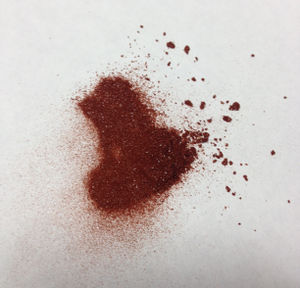Chevreul's salt

| |
| Names | |
|---|---|
| IUPAC name
Copper(I,II) sulfite
| |
| Properties | |
| Cu3(SO3)2 | |
| Molar mass | 386.797 (dihydrate) |
| Appearance | Reddish-brown solid |
| Odor | Odorless |
| Density | 3.57 g/cm3 |
| Melting point | Decomposes |
| Boiling point | Decomposes |
| Almost insoluble | |
| Solubility | Reacts with strong acids Soluble in aq. ammonia, sulfur dioxide |
| Vapor pressure | ~0 mmHg |
| Hazards | |
| Related compounds | |
| Related compounds
|
Copper(II) sulfate |
| Except where otherwise noted, data are given for materials in their standard state (at 25 °C [77 °F], 100 kPa). | |
| Infobox references | |
Chevreul's salt is a peculiar inorganic compound of copper with chemical formula Cu3(SO3)2, systematically naming it copper(I,II) sulfite. This dense red salt is an example of a mixed-valence compound, in this case containing copper is present in both the +1 and +2 oxidation states.
Contents
Properties
Chemical
The chemistry of Chevreul's salt is revealing of the mixed-valence nature of the compound. Addition of Chevreul's Salt to dilute hydrochloric acid precipitates copper(I) chloride, showing the existence of Cu(I). However, Chevreul's salt can also be dissolved in aqueous ammonia showing the existence of Cu(II) as dark blue tetraammine copper(II) complex.
Physical
Chevreul's salt is a dense, deep red compound typically produced in the form of a uniform microcrystalline powder. It is air-stable and insoluble in water but reacts with acids and ammonia.[1]
Preparation
Despite being a very obscure compound, Chevreul's Salt can be very easily synthesized in a matter of minutes. First, a solution of sodium metabisulfite is added to a solution of copper(II) sulfate, forming a grass-green species of unknown composition. The solution can then simply be heated to boiling for a few minutes, gradually darkening to an opaque black. As the boiling subsides, a deep red precipitate quickly falls out of the now-clear solution. As sulfur dioxide is released during the boiling process, it may be necessary to conduct this procedure outside or in a fume hood.
Projects
So far, not enough is known about Chevreul's Salt to have any projects for it, though it is a good candidate for display, being a rarely encountered compound of copper and having an unusual color for its composition. Experiment!
- Electrochemical copper plating (preparation of sodium tricyanocuprate (I));
Handling
Safety
Since not much is known about Chevreul's salt, it should probably be assumed for now that it is not a good idea to allow it entry to one's body. As it is insoluble in water, though, skin contact isn't thought to be an issue.
Storage
Chevreul's salt should be kept in closed containers.
Disposal
Chevreul's salt should be first oxidized with hydrogen peroxide to the more soluble copper sulfate, which can be reduced to copper metal with a more reactive metal, such as iron or zinc.
References
Credit for these findings goes to sciencemadness's MrHomeScientist. The original write-up can be found here: http://thehomescientist.blogspot.com/2013/10/chevruels-salt.html